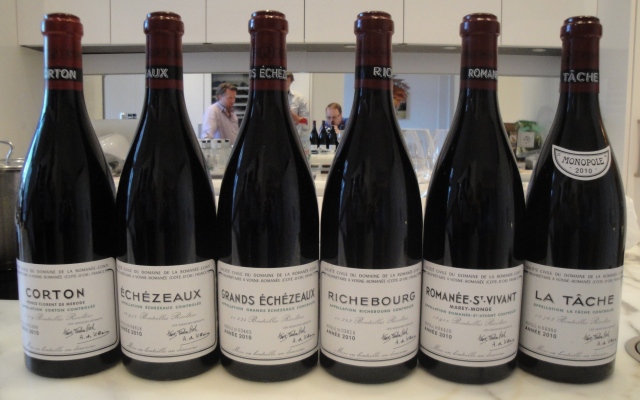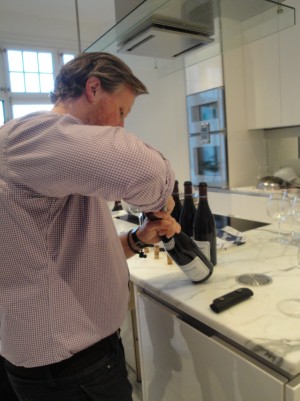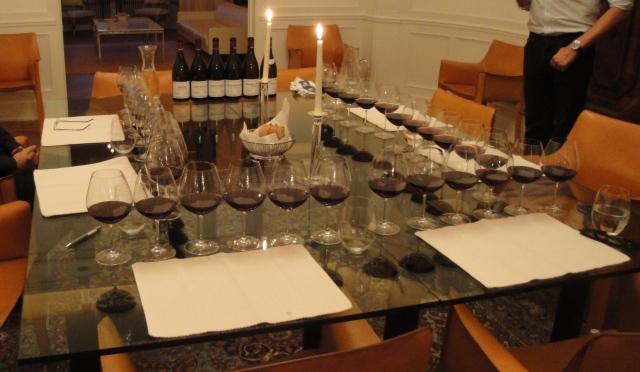The legendary Burgundy domaine Domaine de la Romanée-Conti, usually called DRC, is the producer of some of the world’s best wines. 2010 is a classically styled top vintage in Burgundy with fresh acidity, elegant and pure aromas, and good grape ripeness without excess ripeness or sweetness. The mere thought of a combination of DRC and 2010 therefore makes the mouth of any true Burgundy fan to water. The last year the Swedish importer Vinunic was generous enough to arrange a marvelous tasting of the DRC 2009s – the background I wrote then I won’t repeat here. 2009 was a large vintage from a quantitative perspective (and of very high quality), but 2010 is a unfortunately a smaller vintage. The combination of a truly great vintage and a small quantity naturally means even more worse fighting than usual over the few bottles, so no importer-arranged tasting this year. Despite this, I didn’t want to let go of the idea to taste through most of the DRC wines of this vintage as well, when they are still young and have not closed down. Admittedly, it is something of a crime to drink Burgundies at this level when they have just been released, but as a general rule, this type of wines are more drinkable as young nowadays, and will be more enjoyable directly after release compared to 1-2-3 years later. 2010 is not just a top vintage, but a classically built vintage, and then one can expect that after a couple of years – perhaps already at four years of age, i.e., in 2014 – the wines will enter a more closed-down or “dumb” phase, and will reach maturity only at 10-15 years of age, i.e., 2020-2025, if not later.
I started to look for people who were interested in contributing a bottle of 2010 DRC each to a tasting. This is a bit of sacrifice since these bottles are 1) very hard to lay your hands on to start with, 2) can be sold on immediately at a considerably higher price, and 3) beg to be cellared and enjoyed in a mature state. Despite this, we managed to pull together a tasting of the six DRC wines from Corton up to La Tâche. The two most expensive and most rare, Le Montrachet (white) and Romanée-Conti, I never really expected that we would be able to include, so this was the full set I was looking for. In some vintages, DRC also produces a Vosne-Romanée 1er cru Cuvée Duvault-Blochet but not in the 2010 vintage.
Opening a bottle of DRC just after release and sharing it with other Burgundy fans, instead of just selling it at a hefty profit, is a statement: wine is meant for drinking and enjoying in good company, rather than purely as an investment good.
The tasting took place in an excellent ambience at good adress in Stockholm, with plenty of room to fill the table with a long line of Riedel Burgundy glasses, both for the DRC flight and some bonus wines. Although we all had looked forward to this tasting for a couple of months, there was a certain standstill before the DRC bottles were actually opened and the tasting got going for real. This was not because to the warming-up, in the shape of a white Puligny premier cru from Sauzet and a vintage Krug, took time or took the attention away from the main event. No, a certain nervousness were more to blame, since everyone worried that their own precious bottle would show a cork taint. The iconic bottles were lined up on a table but first it seemed that noone dared to go and start uncorking them. I detected a certain similarity to the feeling before starting first grade in school. This was something that you had looked forward to, but what if you don’t like your class mates and if the teacher turns out to be naughty? Finally, one of the participants uncorked all six bottles with a slightly trembling hand (and a Laguiole), under the supervision of two of us. The rest of the participants remained out on the balcony together with the two warming-up wines, probably to avoid the nerve-wrecking experience of watching the uncorking. The three of us then proceeded to sniff the corks and the bottles in a somber atmosphere. When it turned out that there were no traces of cork taint or any other defect, the feeling of relief was palpable. I’d compare it too the first break in first grade in school, when it turned out that there was no reason to worry over neither class mates nor naughty teachers. When the wines had been poured and the first sniffs confirmed the 2010 DRCs to be just as great an experience as expected, a reverent silence descended upon this priviliged group of tasters, when all concentrated on sniffing their way through the six glasses. Great Burgundies are always “wines of the nose”, and this time the wines were inhaled for quite some time before the first sips were downed.
I can’t remember ever spending this long – several hours – to follow another set of wines. This did the 2010 DRCs good, and has probably led to me scoring the wines about one point higher than under the more regular tasting conditions that applied for the 2009s. In this case, since time in the glass to some extent simulates cellaring time, I simply had better possibilities than usual to estimate “the height of the peak” without going into pure guesswork. This means that I could exchange some of those plus signs (that I often use for young wines) into a higher score that I definitely feels is justifiable. This definitely doesn’t imply that I always score a wine higher if I have it longer in a glass in front of me; on occasion the opposite has happened.
Corton 2010
A blend of the vineyards Clos du Roi, Bressandes, and Renardes. 5 219 bottles (according to the label, the website states a higher number).
Nose with ripe strawberries, cherries, spice, a hint metal filings, some violets, some balsamico. Elegant and fruity impression, a big nose. Palate with cherries, quite pronounced minerality with mint, high and balancing acidity, well embedded medium tannins, long aftertaste with mineral. Very elegant, no trace of sweetness. Can be enjoyed now, will develop well, 94 p.
This wine made is debut in the 2009 vintage, and this second vintage of the wine is rather different than the first, and is a much more classical Burgundy. The 2009 was much more Syrah-like, while the 2010 fits into the DRC lineup in a completely different way. To many of the participants, this was the positive surprise of the evening. The best Corton I have ever tasted.
Échézeaux 2010
14 975 bottles.
Nose with cherries, ripe strawberries, oranges, animal notes with meat juice and dung heap, white flowers and vanilla, some roses; very elegant. Powerful palate, cherries, mineral notes with mint, medium(+) tannins, good acidity, fine balance. Long aftertaste with spice. Rather young but rather approachable now, 95(+) p.
The elegance is typical for Échézeaux, but the wine also has all the power one can wish for in a top notch grand cru. Forget the claims that Échézeaux, also from DRC, is a second-rate grand cru or that the “real” DRC wines start first with Grands Échézeaux. These are not opinions that are based on evaluating the 2010 DRCs (or the 2009s). In the 2010 vintage, I also have the impression that the Échézeaux will require as long as the Grands Échézeaux to reach its peak.
Grands Échézeaux 2010
10 834 bottles.
Nose with really dark cherries, oranges with zest – more specifically zest from a freshly peeled orange that have squired orange juice – animal notes with dung heap, white flowers and roses, mineral notes with gravel; extremely elegant. Powerful palate, ripe strawberries, some cherries, very pronounced mineral notes with mint, long aftertaste with mineral. Rather young, but reasonably approachable now, 96(+) p.
Yes, Grands Échézeaux is a bit more grand than Échézeaux in this vintage as well, but in a different way than in the previous vintage. The 2010 is rather a notch more flowery and elegant (and with less animal notes) than its little sibling, and not really more powerful. Comparing the 2009s, Grands was considerably more tannic, tough and demanding of cellaring than the regular Échézeaux.
Richebourg 2010
11 323 bottles.
The nose is noticeably aromatic, with dark cherries, some balsamico, noticeable spice with toasted oak and coffee, some iron filings. This is the wine that is most closed. Initially I almost got an impression of just a little bit of volatile acidity, and due to the closed-down character the oak comes through more than in the other wines. Palate with cherries, balsamico, strong spice notes, powerful minerality, well integrated medium(+) tannins of a very silky structure, mineral, long aftertaste with cherries and mint. Young, 96(+) p.
In a way quite closed, but the palate is still quite silky and surprisingly feminine for a DRC Richebourg, and not at all a tannic monster. At this point, this was definitely less a “wine of the nose” than the rest, but the greatness and the potential could definitely be felt on the palate.
Romanée-Saint-Vivant 2010
13 910 bottles.
Nose with dark cherries, flowery notes with violets, perfume and roses, some liquorice, spice, some animal notes; very elegant. Palate with cherries, good concentration, fine tart berry notes, powerful mineral notes, well integrated medium(+) tannins of a very silky structure. Young, but somewhat approachable now, 98(+) p.
A marvelous wine with great power, but still with the elegance in focus, that sport where Burgundy is unsurpassed when it is in shape. Another participant described the wine rather strikingly: “the world’s sexiest wine”. To me this is without doubt a better wine than the Richebourg. Comparing to some of the other, the RSV shows more of a “bass note” to its flowery aromas than Échézeaux and Grands Échézeaux do, and in this vintage shows about the same level of tannin as Richebourg (which was less tannic than usual), but more velvet on the palate. Although La Tâche is an even bigger and probably marginally better wine, I would rather like to retaste the 2010 RSV in the near term, since it provides more pleasure in its current young state.
La Tâche 2010
15 763 bottles.
Powerful nose with strong animal notes with some dung heap, dark cherries, some blood grapefruit, flowery notes with violets, gravel, hints of iron filings, spice and some stems. Definitely elegant. Palate with cherries, quite concentrated, powerful mineral tones with gravel and mint, noticeable spice notes, medium+ tannins, good acidity, long aftertaste. Young, needs time, 98+ p.
As usual, La Tâche is a larger and tougher wine than the rest, and shows more traditional Burgundian character with some evidence of stems, i.e., a hint of green notes. There are three unanswered questions after I have tasted the La Tâche 2010: will it peak at 99 or 100 points? Is really the 2010 Romanée-Conti 2010 even better? And what should I do to be able to taste it again when it has matured?
Summing up, compared to the 2009s, the 2010s show slightly less dark aromas, on average a little less tannin, but more mineral notes, more fresh acidity and even more elegance. I found Échézeaux, Romanée-Saint-Vivant and La Tâche to be stylistically rather similar between the two vintages, while Corton, Grands Échézeaux and Richebourg differed more.
This tasting was definitely something out of the ordinary, a truly great wine experience that I would wish more people were able to experience for themselves. I don’t think that anyone of us who took part in any way felt any regret for “sacrificing” a bottle of 2010 DRC in this young state. Instead, we all agreed that this was a very reasonable use of a bottle, and something that must become an annual habit!
So, when should one drink these wines? Corton, Échézeaux, Grands Échézeaux and Romanée-Saint-Vivant can definitely be drunk with pleasure over the next year, but should preferably be decantered for a couple of hours before. After that, I recommend waiting until at least 2020 (10 years), and even better until 2025 (15 years). Richebourg and La Tâche should probably be drunk first from 2o25 (15 years), and if you can wait until 2030 (20 years) before opening a La Tâche, this should be even better.
I’ll come back to the wines we used for warming up, and the bonus wines, in a later post. These wines were also quite spectacular.
The Swedish version of this post can be found here.



Pingback: BKWine Brief nr 121, September 2013 | BKWine Magazine |BKWine Magazine
Pingback: Domaine de la Romanée-Conti Romanée-Saint-Vivant 2010 | Tomas’ Wine of the Month | BKWine Magazine |BKWine Magazine
Pingback: Domaine de la Romanée-Conti, the 2012 vintage | Tomas's wine blog
Article writing is also a fun, if you be acquainted with then you can write otherwise it is complicated to write.
Excellent write-up. I absolutely love this website.
Stick with it!